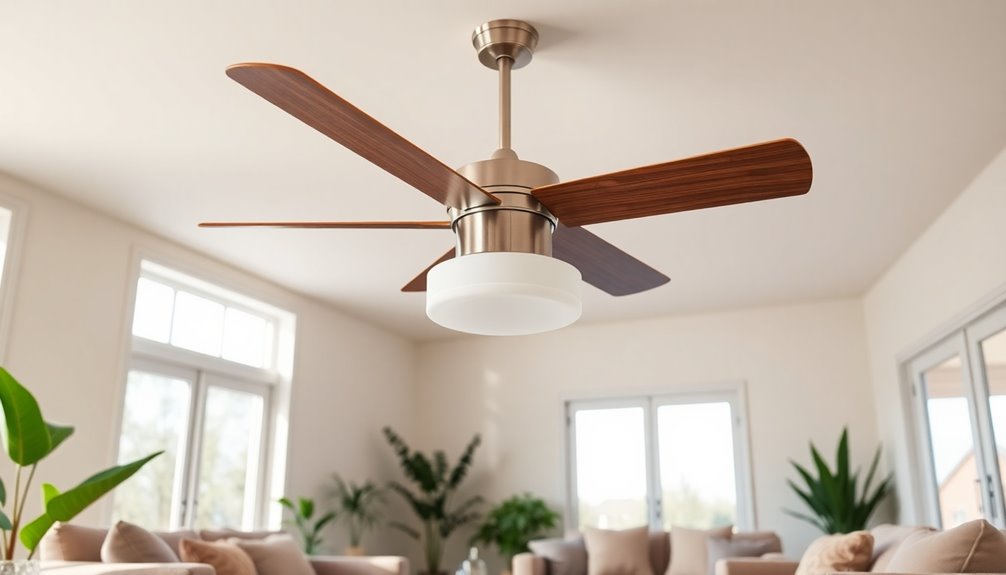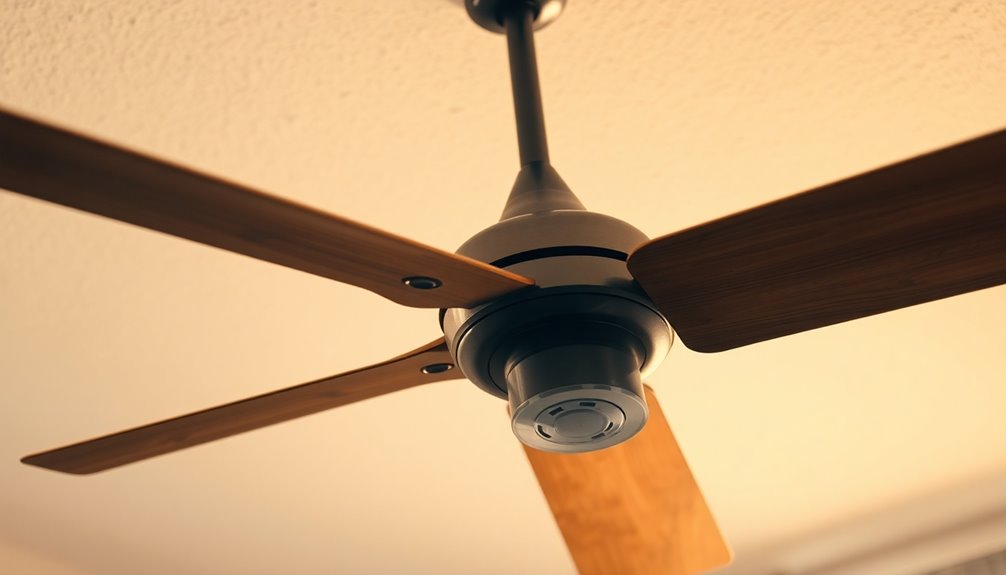A hugger ceiling fan is a low-profile fan designed for rooms with ceilings of eight feet or less. It installs directly against the ceiling, maximizing your space while providing efficient airflow. You won't need cumbersome downrods, making it a safe choice, especially in kids' rooms. Many models come with integrated lighting, blending function with style. Plus, they're energy-efficient and often feature reversible motors for seasonal comfort. Whether you're sprucing up a small bedroom or a compact living area, a hugger fan fits right in. Stick around, and you'll discover more about their benefits and installation tips!
Key Takeaways
- Hugger ceiling fans, or flush mount fans, are designed for low ceilings, typically eight feet or less, to maximize vertical space.
- They install directly against the ceiling, ensuring safety and reducing obstruction risks, making them ideal for compact spaces.
- These fans can provide both air circulation and integrated lighting options, enhancing room functionality without clutter.
- Many models feature reversible motors for seasonal airflow adjustments and are often energy-efficient, contributing to energy savings.
- Hugger fans are perfect for small rooms like bedrooms, offices, and kitchens, particularly in environments where safety is a concern.
Definition of Hugger Ceiling Fans

When you're looking for a ceiling fan that fits snugly against the ceiling, hugger ceiling fans, also known as flush mount fans, are your best bet. These low profile ceiling fans are specifically designed to be installed directly against the ceiling, making them perfect for rooms with low ceiling heights of eight feet or less.
Unlike regular ceiling fans, hugger fans don't use downrods, which means they eliminate the need for additional hanging space while still providing effective air circulation.
Hugger ceiling fans typically maintain a minimum height clearance of seven feet from the floor, ensuring safe operation in compact spaces. This design allows you to maximize your room's vertical space without sacrificing airflow and comfort.
You'll find that these fans come in various styles and finishes, allowing them to blend seamlessly with different interior décors.
Moreover, hugger fans are versatile enough for both indoor and outdoor use, with specific models rated for damp or wet conditions. This adaptability means you can enjoy the benefits of a flush mount fan in various living environments, from cozy bedrooms to covered patios.
Advantages of Hugger Fans

Hugger ceiling fans offer several advantages that make them an excellent choice for homes with low ceilings. Their low-profile design allows you to install them in spaces with eight-foot ceilings or less, ensuring safety and ideal airflow without sacrificing headroom. You won't have to worry about bumping your head or feeling cramped; these fans fit snugly against the ceiling.
The flush-mounted design eliminates the need for downrods, making them ideal for compact living areas where every inch counts. Many hugger fans are also energy-efficient, often carrying ENERGY STAR ratings and incorporating LED lighting, which helps lower your long-term energy costs.
Versatility is another significant advantage. Hugger fans come in various finishes and styles, allowing you to match your decor while enhancing air circulation throughout your space.
Plus, they comply with safety standards, hanging at least seven feet above the floor to reduce the risk of accidents.
Comparison With Regular Ceiling Fans

Choosing the right ceiling fan for your space can greatly impact both functionality and aesthetics. When considering hugger ceiling fans, also known as flush-mount ceiling fans, you'll find they're specifically designed for areas with lower ceiling heights of eight feet or less. This makes them an excellent choice for compact spaces since they mount directly against the ceiling, eliminating the need for downrods.
In contrast, regular ceiling fans require a minimum clearance of seven feet from the floor, which can be limiting in tighter rooms. Regular fans offer versatility with adjustable downrods, allowing ideal airflow in spaces with higher ceilings. However, this added flexibility can pose a safety risk in low-clearance areas, where hugger fans excel by reducing the chance of obstruction or accidental contact.
Both types provide similar airflow benefits, but hugger ceiling fans guarantee effective circulation without protruding into your living space. If you're dealing with lower ceilings, you'll appreciate the safety and style that flush-mount ceiling fans bring, while regular fans may better suit larger rooms where ceiling height isn't an issue.
Ideal Spaces for Hugger Fans

For spaces with lower ceiling heights, hugger ceiling fans shine in their ability to provide both comfort and style.
These fans are perfect for rooms with ceilings of eight feet or less, ensuring you can enjoy effective air circulation without any obstruction. If you're looking to cool down a small bedroom, home office, or kitchen—where low ceilings are common—hugger ceiling fans are your best bet.
They're also ideal for compact living areas like apartments or condos, where maximizing vertical space is essential. In these environments, every bit of space counts, and a hugger fan won't detract from your room's height.
Additionally, consider using these fans in basements and attics to improve air movement in areas that may otherwise feel stuffy due to low ceilings.
Hugger fans are particularly suited for children's rooms and playrooms, where safety and space efficiency are top priorities.
You'll appreciate how they blend seamlessly into the décor while keeping the air fresh and comfortable.
Installation Considerations

When installing a hugger ceiling fan, it's vital to take into account safety and compliance with regulations, especially in spaces with lower ceilings. Hugger fans are designed to be flush mounted, making them perfect for rooms with a ceiling height of eight feet or less.
However, make sure the fan is installed at least seven feet above the floor to meet safety standards and prevent potential hazards.
One of the key installation considerations is using a fan-rated junction box that can support the weight and motion of the fan. This guarantees stability and safety during operation.
Additionally, proper wiring is essential; it must match the fan specifications and typically requires a minimum gauge for peak performance.
Before you begin the installation, double-check your ceiling height and the placement of the fan to maximize airflow and efficiency. Ensuring the fan has a high CFM rating is crucial for optimal air circulation in your space.
Remember, a well-installed hugger fan not only enhances your space but also operates quietly and effectively.
Maintenance Tips for Hugger Fans

To keep your hugger ceiling fan running smoothly, establish a regular dusting schedule for the blades and housing.
Use gentle cleaning techniques to avoid damaging the finish while ensuring ideal airflow.
Regular Dusting Schedule
Establishing a regular dusting schedule is vital for keeping your hugger ceiling fan in top condition. Aim to clean the fan blades at least once a month to prevent dust buildup and maintain ideal airflow.
Use a microfiber cloth or a soft dusting tool to gently wipe the blades, and steer clear of harsh chemicals that could damage the finish.
If your fan is in a kitchen or another high-grease area, consider increasing your cleaning frequency to bi-weekly. This helps combat grease and dirt accumulation that can affect the fan's performance.
Always make sure the fan is turned off and completely cool before starting any maintenance to avoid accidents or injuries.
In addition to cleaning the blades, periodically check the fan's motor and other components for dust and debris. Keeping these areas clean is vital for maintaining performance and longevity.
By establishing a regular dusting schedule, you'll not only enhance the visual appeal of your hugger ceiling fan but also guarantee it operates efficiently for years to come.
Regular maintenance is key to enjoying a clean and functional fan in your space.
Blade Cleaning Techniques
Cleaning the blades of your hugger ceiling fan is essential for maintaining its performance and appearance. To start blade cleaning, always turn off the fan and verify the blades have stopped moving for safety.
Use a microfiber cloth or a soft feather duster to gently remove dust and debris from your Low Profile fan. This method helps avoid scratching the surface.
For stubborn grime, mix a solution of mild soap and water. Dampen a cloth with this solution and wipe the blades, then follow up with a dry cloth to prevent moisture buildup that could harm the fan.
Aim to clean your fan blades at least once a month to maintain peak airflow and prevent dust accumulation that can affect performance.
Popular Styles and Designs

While many ceiling fans can dominate a room, hugger ceiling fans blend seamlessly into your decor, offering both style and function. These flush-mount fans are perfect for spaces with ceiling heights of eight feet or less, ensuring you don't have to compromise on comfort or aesthetics.
Available in an impressive range of styles and finishes, you can easily find a hugger ceiling fan that complements your home's design, whether you prefer modern, traditional, or industrial looks.
Many hugger fans also feature integrated lighting options, such as LED kits, which not only provide air circulation but also illuminate compact spaces effectively. This dual functionality allows you to maximize your room's potential without cluttering it with additional light fixtures.
Additionally, popular brands like Minka-Aire and Hunter offer a variety of collections, ensuring you have plenty of choices tailored to your needs.
Look for models with reversible motors, which enable you to adjust airflow according to the season, enhancing comfort year-round. With so many options, you're sure to find the perfect hugger ceiling fan to elevate your space.
Frequently Asked Questions
What Does a Hugger Ceiling Fan Mean?
When you hear the term "hugger ceiling fan," it refers to a type of fan designed for lower ceilings.
You'll find these fans mounted directly against the ceiling, eliminating the need for downrods. This design not only saves space but also guarantees safety by minimizing obstructions.
Despite their compactness, they still provide effective air circulation, making them a great choice for rooms with eight-foot ceilings or less.
Plus, they come in various styles!
What Is the Difference Between Hugger and Non Hugger Fans?
The difference between hugger and non-hugger fans lies in their design and suitability for ceiling heights.
Hugger fans mount flush against the ceiling, making them perfect for low spaces. Non-hugger fans, on the other hand, use downrods to hang lower, offering better airflow for higher ceilings.
You'll find that hugger fans create a sleek look, while non-huggers provide a more dramatic presence in your room.
Choose based on your ceiling height and style preference!
Is It Better to Have a Flush Mount Ceiling Fan?
It depends on your space and needs.
If you've got low ceilings, a flush mount ceiling fan's definitely a better choice. It'll circulate air effectively without taking up vertical space, so you won't feel cramped.
Plus, many of these fans come with energy-efficient features, saving you money on bills in the long run.
With various styles available, you can easily find one that complements your home decor while keeping you comfortable.
What Ceiling Height Is Needed for a Hugger Fan?
For ideal performance, you'll want a ceiling height of 8 feet or less for a hugger fan.
It's essential to install it at least 7 feet above the floor to meet safety standards. This guarantees you have adequate airflow without conflicting with your space.
Conclusion
In the grand dance of home comfort, hugger ceiling fans waltz effortlessly into your space, offering both style and function. They're perfect for low ceilings, keeping you cool without compromising your headroom. As you bask in the gentle breeze, remember that these fans blend seamlessly into your décor, much like a well-timed note in a melody. So, whether you're jazzing up a cozy nook or a lively room, hugger fans are your perfect partners in airflow.









